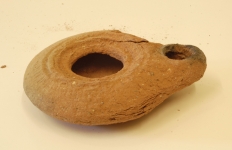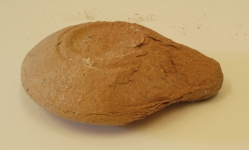
Fig 1. Before, showing the lamp with large crack in the fabric, friable surface and extent of surface loss.
Added by Cheryl Wolfe on 29/07/2008


The terracotta lamp is in the form of a small, round dish, with a turned-in rim and separate aperture for the wick. There is some decoration around the turned-in rim in the form of short indented lines radiating out from the central aperture. It measures 85mm in length with a width of 67mm and a depth of 25mm. Although it is noted on the museums inventory as being Roman of unknown period there is the possibility, from the style of the lamp, that it may be Syrian in origin.
The front part of the lamp is extremely friable and a large area of the surface has been lost with the underside of the lamp in this area is also suffers the same problems. Delamination is occurring in the interior of the lamp too, and a collection of fragments has built up inside the lamp. It can be safely assumed that the whole front section of the lamp is afflicted.
To determine on how to consolidate the delaminating clay, which consolidant to use, and appropriate percentage required; loose fragments retrieved from the interior of the lamp and also those gathered from the tissue wrapped around the lamp, were used as test material.
Initial thoughts are to use varying percentages of Paraloid B72 (Ethyl methacrylate co-polymer) in Acetone (organic solvent ketone class). However there is a possibility that acetone may evaporate off too quickly. If this were to be a problem then Xylene (hydrocarbon solvent) could be used.
Using a very low percentage such as a 1% or 2%, this would absorb into the matrix of the clay and act like a cement. The lower the percentage would prevent it becoming shiny and also prevent the higher concentrations required, to adhere the larger flakes into place, penetrating into the fabric and being glossy.
Consolidation and Adhesion Tests.
Three different percentage solutions of Paraloid B72 were made up in Acetone. Granules of Paraloid B72 were weighed out as follows: 0.5g; 1.25g; and 2.5g. Each of the weighed granules was mixed in 50ml of Acetone, and was correctly labelled with the appropriate hazard labels. Small mounds of debris material were put together, using both the finer powdery granules and larger flakes, so tests could be carried out on these samples of the clay.
Using a sheet of 75 micron thickness Melinex ™, six small mounds of these fragments were prepared and the following treatments applied. (See table 1).
|
Mound |
1% solution |
2.5% solution |
5% solution |
Results |
|
1 |
1 application |
x |
x |
No adhesion |
|
2 |
1 application |
1 application |
x |
No adhesion |
|
3 |
1 application |
1 application |
1 application |
Some adhesion |
|
4 |
3 applications |
x |
x |
Some adhesion |
|
5 |
3 applications |
3 applications |
x |
Small particles and fragments adhered |
|
6 |
3 applications |
3 applications |
3 applications |
Full adhesion |
Table 1 Initial consolidation and adhesion tests.
From the results obtained from the above tests, it was decided to conduct several more tests on fresh mounds of clay fragments.
|
Mound |
1% solution |
2.5% solution |
5% solution |
Results |
|
1 |
3 applications |
1 application |
x |
Adhesion apart from large flakes |
|
2 |
3 applications |
2 applications |
x |
Adhesion apart from larger flakes |
Table 2 Secondary tests for consolidation/adhesion.
These were also found to be unsatisfactory, so it was then decided to produce a 2% solution of Paraloid B72 in Acetone.
|
Mound |
1% solution |
2% solution |
5% solution |
Results |
|
3 |
1 application |
2 applications |
x |
Adhesion apart from larger flakes |
Table 3 Final test for consolidation and adhesion.
None of the lower percentage solutions seemed to adhere the larger flakes to the substrate, so it was decided to use the 5% solution to achieve this. Application of the 5% solution was administered using a hypodermic needle to insert the consolidant beneath the flake. Any slight over spill was removed immediately with a small swab dampened with Acetone.
The final conservation treatment plan derived from the above experiments proceeded in the following manner. The exterior of the lamp was treated first using the 1% solution of Paraloid B72 in Acetone applied with a hypodermic needle. The solvent was allowed to evaporate off before the same area was treated with an application of the 2% solution of Paraloid B72 in Acetone, via a hypodermic needle. Once again the solvent was allowed to evaporate away prior to the second application of the 2% solution. For the sections where the clay was delaminating in thicker, larger flakes, the 5% solution was injected very carefully into the large gaps and underneath the flakes to ensure adhesion. On the odd occasion of very slight over-spill, the 5% solution was removed immediately using cotton wool swabs wetted with Acetone. This application of the 5% solution was allowed to cure before testing for strength of adhesion, and repeated as and where necessary until a satisfactory result had been achieved.
When the exterior of the lamp had been satisfactorily consolidated, attention was paid to the interior of the lamp. Any remaining loose fragments were removed and then the interior consolidated primarily with the 1% solution, and once the solvent had evaporated away, the process repeated with the 2% solution.